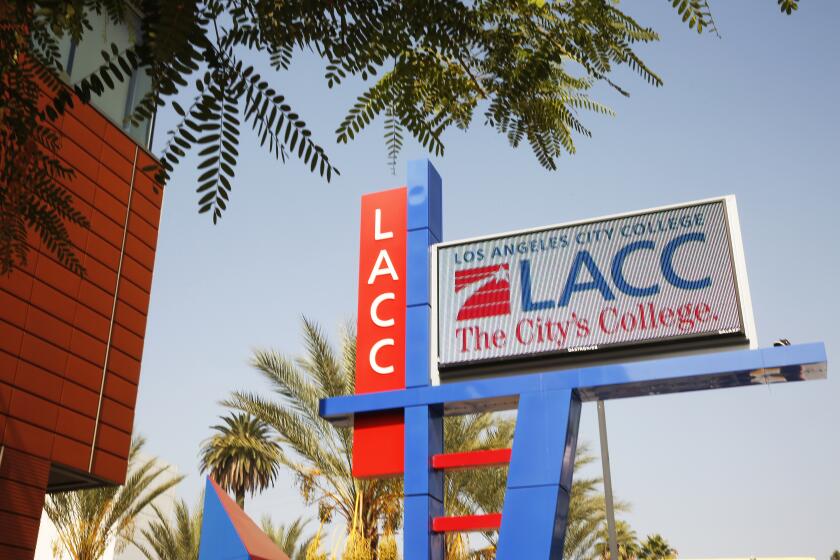Editorial: U.S. colleges are overusing — and underpaying — adjunct professors

- Share via
Undergraduates attending any of the California State University schools probably figure they’re being taught by well-paid, longtime professors. Sometimes they are. But more often, their teachers are low-paid “contingent faculty” — adjunct professors who work under contract, without a permanent job or the possibility of tenure.
Many CSU adjuncts have a PhD, but still make less working full time — about $64,000 a year — than the average California public school teacher, and with fewer benefits and little job security.
Because they are unionized — and under a new tentative contract, they will receive significant raises — Cal State’s contract instructors are at least doing better than the 250 contingent faculty who make up 75% of the teaching staff at University of Southern California’s highly regarded film school, according to James Savoca, an adjunct associate professor of film directing.
Homeless college students who live in their cars need safe overnight parking. How tough can that be?
Colleges such as Cal Poly Humboldt resist allowing overnight parking for students who live out of their cars. Long Beach City College shows a better way.
Many are current or retired Hollywood professionals who earn an average of $20,000 for teaching two courses, per academic year, which is considered a 20-hour-a-week job during the school year, Savoca said. Low pay is among the reasons that Savoca and other adjunct film school faculty at USC are trying to form a union. They recently presented USC with a petition signed by 80% of the adjunct professors, asking to have the union recognized. The university administration responded that the contingent faculty doesn’t need a “third party” to speak for them. A formal vote by adjuncts will be held soon.
Reliance on low-paid adjuncts is common among U.S. colleges and universities. The American Assn. of University Professors reports that 70% of faculty are adjunct, most of them without benefits, job security or union representation; they teach more than half of all college courses in the U.S. Many must patch together part-time gigs to support themselves, with salaries that don’t reflect their professional expertise or level of education.
Except for a handful of colleges where contingent faculty have organized and negotiated better pay, underpaid adjuncts are an unfortunate cost-saving feature at America’s institutions of higher education. The situation at Cal State shows that even unionization hasn’t always resulted in fair pay for their credentials and work, just better pay. A 2012 survey found that the median pay for unionized adjuncts was about 25% more than those without unions.
There’s a tremendous gap in resources between students at schools like Harvard and the resilient, determined students at community colleges.
Colleges can generally terminate an adjunct instructor abruptly and for no reason. Other adjuncts tire of the situation quickly; turnover is high, which means the instructors are more likely to have little institutional knowledge and experience.
Some adjuncts are fully employed professionals in their field and pick up a course as a way of passing their knowledge to a new generation. But that’s the exception, according to the AAUP report. Many more count on teaching to get by financially. Either way, faculty should be paid at their full worth, and that happens rarely.
Nearly a quarter of adjunct professors rely on public assistance such as unemployment benefits during the summer or other non-teaching periods, according to a 2020 report by the American Federation of Teachers. That means taxpayers are subsidizing this situation. A 2022 survey by the AFT found that 1 in 5 adjuncts rely on Medicare or Medicaid for health insurance. That’s particularly galling for faculty at private colleges where students and their families pay tens of thousands of dollars each year in tuition.
Universities were never meant to be merely career-prep schools. But more universities are shrinking non-STEM departments.
This arrangement isn’t just bad for the adjuncts, it’s harmful to their students and schools: Because they have so little job security, adjunct professors don’t have the same level of academic freedom as their tenured counterparts and are less likely to take risks in the classroom or in their work, the AAUP report said. That means they’re less likely to be innovative or introduce provocative material, because those can be controversial.
The lack of security and pay also may lead underpaid adjuncts to take shortcuts as they try to juggle enough work to make a living, according to Helena Worthen, co-author of a book on contingent faculty. For example, they are less likely to defend a student challenge to a deserved low grade because the process is long and time-consuming, and the instructor gets no extra pay for it. Some adjuncts also limit the number of letters of recommendation they will write, Worthen said, or conduct office hours only by phone.
Colleges might plead poverty, but student applications are up this year. Overall, according to the AAUP report, adjunct hires increase most in times of college expansion.
Limited funds or not, there is no more important place for colleges to spend their money than hiring the best instructors they can find and providing fair pay, benefits and reasonable working conditions.
More to Read
A cure for the common opinion
Get thought-provoking perspectives with our weekly newsletter.
You may occasionally receive promotional content from the Los Angeles Times.













